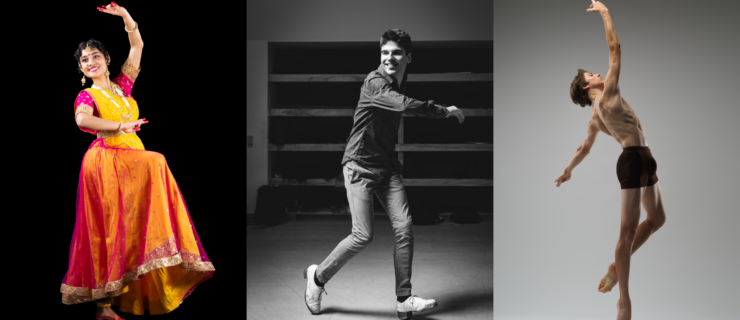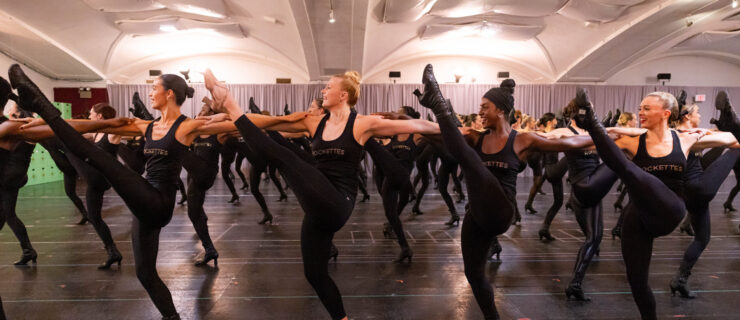Collaborative Choreo: How to Make Work with Another Choreographer
Choreographing a dance means standing alone at the front of the studio…right? Not necessarily! Many choreographers prefer making work with a partner. Two heads can definitely be better than one, but creating collaboratively does come with some strings attached. Whether you’re working in a duo or group by choice or you’ve been assigned to develop a piece with someone else, try these tips to foster a positive process.
Prepare Together
Brainstorming in advance can start your project off on the right foot. For Audrey Lane Ellis and Sarah Capua, contemporary dancers who choreograph jointly as a+s works, the creation of a new piece starts long before they enter the studio. “Our process often begins with a tiny seed—like a quote or an image—that sparks a dialogue,” Ellis says. They’ll continue talking and sending snippets of inspiration back and forth until rehearsals actually begin. Then, Ellis explains, “studio time becomes playtime for how those elements we’ve discussed can be expressed through movement.”
Preparation can also help you avoid unnecessary conflict during rehearsals. “Once dancers are in the room with you, it’s a higher-stress environment,” says Elizabeth Petrin, who choreographs commercial projects with Mandy Korpinen; the two have had routines featured on the last two seasons of “So You Think You Can Dance.” “It’s better to hash things out beforehand, if you can.”
Explore Everything
One of the best parts of collaborating? “Bouncing ideas off each other,” says Korpinen. “When one of us gets stuck, the other is there to help out.” You won’t be able to take full advantage of this perk unless you approach the entire process with an open mind.
Most collaborations are launched because you share a movement style, an artistic philosophy, or a personal relationship. But even with those commonalities, things won’t always click in the studio. You might have to resort to a bit of trial and error to merge your individual voices into something fresh.
 Marko Germar (left) and Koine Iwasaki in You’re The Last Thing On My Mind, choreographed by Mandy Korpinen and Elizabeth Petrin, on “So You Think You Can Dance” (photo by Adam Rose, courtesy Fox)
Marko Germar (left) and Koine Iwasaki in You’re The Last Thing On My Mind, choreographed by Mandy Korpinen and Elizabeth Petrin, on “So You Think You Can Dance” (photo by Adam Rose, courtesy Fox)
Sara Hook, who teaches composition at the University of Illinois, offers a few exercises that might help. “For duos,” she says, “have one person perform a phrase, while the other tries to interfere.” Or you might assign each other to make a sequence with specific limitations: “Say you have to touch the whole time, or travel in ways that don’t include running or walking,” Hook says. As you explore possibilities together, don’t be afraid of what Ellis calls “productive failure.” Sometimes you have to push past what isn’t going to work in order to reach what’s right.
Play to Your Strengths
Think about how you and your collaborator complement each other. For example, Ellis says she tends to rely on Capua to find the right music for their work, while Capua praises Ellis’ ability to distill many ideas into a cohesive vision. Petrin says that she’s a bit more conceptual, while her partner Korpinen has stronger musicality.
Keep in mind that if you collaborate long-term, the dynamic might shift from project to project. Brothers Rich and Tone Talauega, of Rich + Tone Productions, who have choreographed together since they were teenagers, have a client roster that includes Madonna, Pink, and Jennifer Lopez. Rich says that Tone often gets the ball rolling, and then he develops the concept further, but “sometimes it’s vice versa. It all depends on who comes in with the strongest idea at the start—that person usually takes the lead.” Know what you each have to offer, but be flexible, too.
Trust the Process
In a true collaboration, everyone’s voice gets heard. “When you’re working in this way, it’s not about you,” Capua says. “If your partner has a different vision, you can’t take it personally. There’s never a reason not to give something a try. You’re choosing to value process as much as product.”
“When you’re working with a partner, you have to stay humble,” agrees Rich Talauega. “Ego will only get in the way.”
Of course, it’s easier to feel comfortable—and to let yourself be vulnerable—when you’ve known each other a long time. But that doesn’t mean you can’t build a strong bond with someone new. Hook’s co-choreographers have included David Parker and Paul Matteson, both artists whose work she admired, but whom she didn’t know well prior to teaming up.
Ready to leap into your first choreographic collaboration? Look for someone you feel in sync with, artistically and/or personally, but be ready to take risks—and to disagree. Bring your own ideas to the table, but find compromises when you can. Above all, enjoy having another person on this creative journey with you. If you’re lucky, you’ll find someone you want by your side in the studio for years to come.
A version of this story appeared in the May/June 2018 issue of
Dance Spirit with the title “Collaborative Choreo.”




